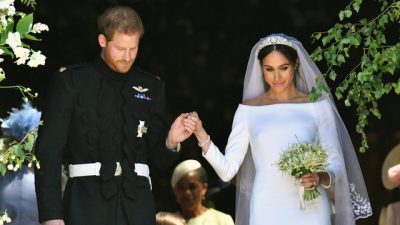A Very Republican Sickness: Loving Royal Weddings

“Thinking that you actually know a public figure – in the intimate, best-friend kind of way – is not healthy.” – Katie Stow, Harper’s Bazaar, Oct 17, 2017.
The citizenry of the US Republic might well insist on the sanctity of its laws, a prided exceptionalism and the genius that is the Constitution, but there is no provision as to how to combat a known, recurring sickness: royal watching and monarchical mania. The House of Windsor continues to pull people out of beds and from their tasks with hypnotic appeal, most notably during a wedding occasion.
The nuptials of Prince Harry and Meghan Markle seem the stuff of a regressive nightmare, a progressive’s conversion to the forces of reaction and misplaced adoration. As a social statement, it is conservative and defiantly anti-modern. Nevertheless, networks such as CNN insist that the Hollywood actress is the quintessential opposite: a feminist figure, a modern statement, a potential reformer. The network reported her own remarks of being “proud to be a woman and a feminist” and her determination to make a “bold feminist statement” in walking down the aisle unchaperoned.
The ceremony itself tried to buck the musty, staid manner typical of such occasions. At times, it seemed that an evangelical stir combined with gospel theatrics would grip the gathering and send it into hysterics.
Bishop Michael Curry of Chicago did his best to take the occasion by the throat, doing a merry zigzag between the “redemptive power of love” (a la Martin Luther King), Jesus not getting “an honorary doctorate for dying” and various lusty references to Promethean fire:
“There was no Bronze Age without fire, no Iron Age without fire, no Industrial Revolution without fire.”
While the heavy American presence at the Harry-Markle show might explain the level of interest back in the US, the fascination from across the Atlantic pond has been a lingering one. Deposing tyrannical monarchy and creating a republic did not banish the associated romanticism of having hereditary rulers – and inbred ones at that.
“The American people are quite fond of the royal family,” explained former President Barack Obama to Prince Charles at a meeting in 2015. “They like them much better than their own politicians.”
Research justifying monarchist mania has been sought with vigour, and inevitably, psychologists have been pressed on the issue. Tara Emrani’s work, done from her perspective as a licensed clinical psychologist, gives a sound tick of approval to the British royal family in finding “a way to stay relevant and present in the media.” The portrayal of “the family is very relevant to the people in that they have a family, they do normal stuff, they go to normal places, although their royal.”
Such are the delusions of perceived normality, but Emrani wishes to run on it.
“The Duchess [Kate Middleton] recently talked about mental health and hunger and Prince Harry does a lot of charity work and things that people can admire, are inspiring, and feel relevant.”
Home grown substitutes have been sought. The US Republic has had a lengthy string of dynastic rulers. The Kennedys and Camelot was a very American attempt to seek the appropriated gloss of an indigenous royal family, to anoint this genetic compound with aristocratic credentials. It also had the elements of stage management and direction. Royal weddings serve to generate fantasy and hope, that unenviable and sinister nonsense that little girls can eventually grow up to marry a prince.
The prince who meets the commoner, albeit one birthed in the Hollywood dream bubble, has been the logical extension of that other “commoner” myth sired from the legend of Princess Diana. It was soon forgotten that Diana was herself an aristocrat rather than being the People’s Princess as designated by the New Labour of Tony Blair. The response to her death had a certain pathological, even totalitarian quality to it, leading the late Christopher Hitchens to remark that Britain had become, for a time, a “one-party state”.
The tension between modern trends and conservative institutionalism was only artificially demonstrated at St. George’s Chapel in Windsor Castle. Black spiritualism tagged on to exaggerated feminist values mixed with traditional forms certainly gave an impression of difference, but these were daubs rather than extensive splashes.
The trick worked for some, not least the selection of Curry as wedding pastor, “an important move,” assessed Jonah Waterhouse, “as Meghan Markle is the first notable African American member of the British royal family.” Markle, it has already been forgotten, is not there to inflict change upon the institution of monarchy, but be changed by it.
Between the monarchy and Hollywood lie certain similarities, and the modern British monarchy is very mindful of the power of image, the strength of a manufactured product. Hilary Mantel’s controversial but entirely sensible summation of Kate Middleton, the Duchess of Cambridge, as “becoming a jointed doll on which certain rags are hung” was apt if slightly cruel. She had been “a shop-window mannequin, with no personality of her own, entirely defined by what she wore.”
The most striking, and somewhat damnable feature of such confections as took place on Saturday is a certain genius on the part of Queen Elizabeth II and company. They have managed to seduce those of republican tendency, to drive them potty with the seduction of celebrity. While she will be the last monarch of her type, the institution does not risk going asunder before any bomb throwing revolutionary, actual or metaphorical. Dolls, and suitable rags, will continue being sought, and royal weddings will persist in enthralling.
*
Dr. Binoy Kampmark was a Commonwealth Scholar at Selwyn College, Cambridge. He lectures at RMIT University, Melbourne. He is a frequent contributor to Global Research and Asia-Pacific Research. Email: [email protected]

